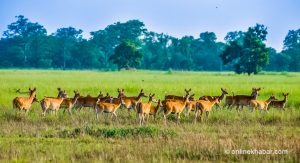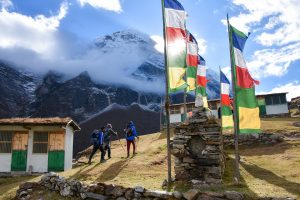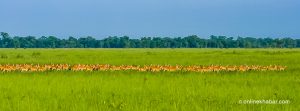
Nepal’s geography is unique. There are the plains in the south, the Himalayas in the north and lots of hills in the middle. This means the country is incredibly rich in biodiversity and wildlife. Where else in the world can you find both the royal Bengal tiger and the snow leopard? Nepal has them both; there are more such species in the national parks in Nepal.
Here is a list of national parks in Nepal and the information about wildlife and biodiversity that you can find here.
1. Chitwan National Park
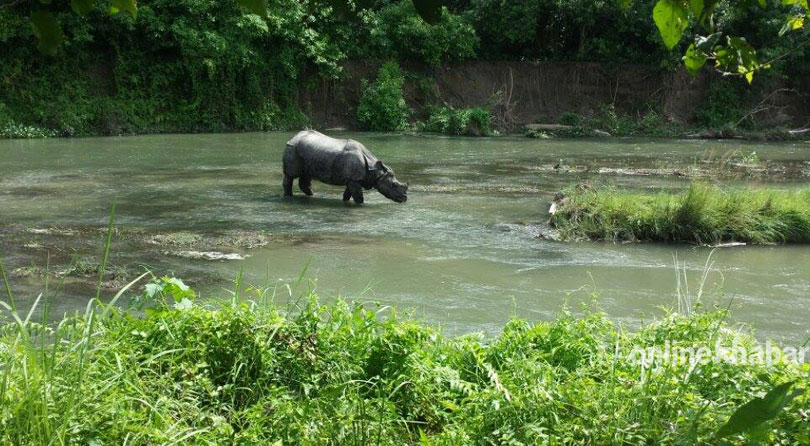
Chitwan National Park is known for its rich biodiversity. Also a UNESCO World Heritage site, the national park is home to over 700 wildlife species including endangered species like the Bengal tiger, the one-horned rhino and the gharial to name a few. It is also home to Asian elephants, leopards, sloth bears, deer and wild boars.
Since the park has both dense forests and wetlands, it is an ideal place for birds too. People from all over the world come here to see birds like the Bengal florican, the giant hornbill, the lesser florican, the Asian paradise flycatcher, the blue-throated barbet, the great egret, the spotted eagle, and the white-throated kingfisher.
The place also has a wide range of aquatic animals like the mugger crocodile, gharials, Indian python, freshwater turtles and several species of fish, including the catfish, mahseer and carp. The oldest among the national parks in Nepal, Chitwan is also known for its butterfly and insect diversity, with over 150 species of butterflies and countless species of insects.
Sal trees dominate the national park with over 70 per cent coverage with riverine forests covering most part of the national park along with grasslands.
Best time to visit: February – April
2. Makalu Barun National Park
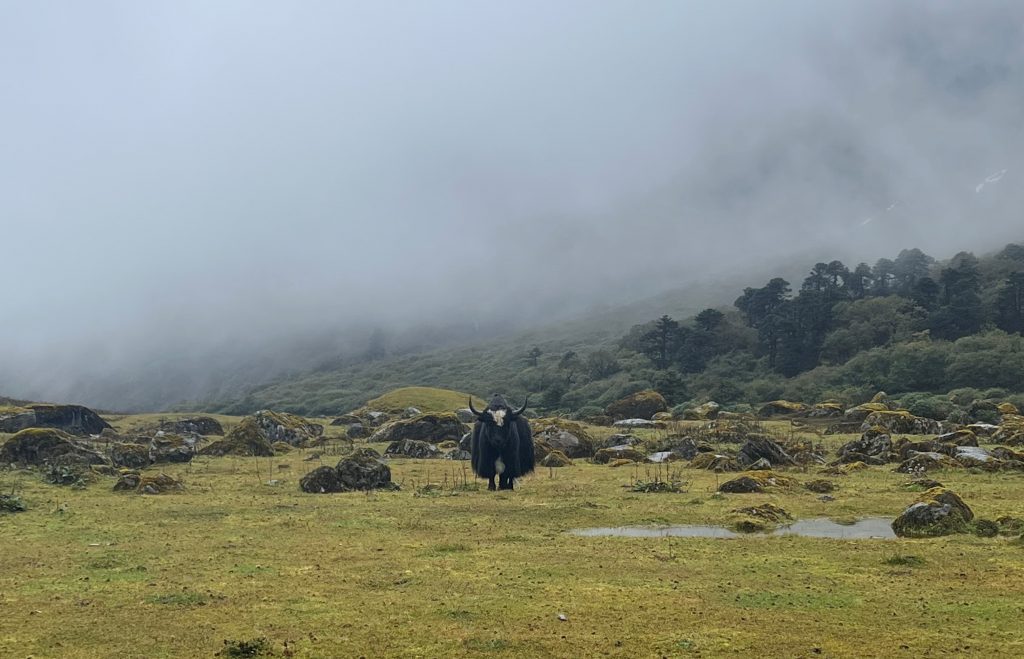
Located near the mountains, Makalu Barun is home to several rare and endangered species. People have reported citings of snow leopards, red pandas and the Himalayan tahr. The national park also has clouded leopards, Himalayan black bears and musk deer. The park is also home to different species of primates, including the Assamese macaque and the grey langur.
One of the underrated national parks in Nepal, Makalu Barun is a birdwatchers’ paradise with over 400 species of birds found in the area. Birds like the Himalayan monal, satyr tragopan, snow pigeon, yellow-billed chough, and several species of eagles, falcons, and vultures are found in the area.
The forest is full of rhododendron, oak, pine, and fir trees, and also has different species of bamboo. Locals say the park also has different medicinal plants like the yarsagumba, which is highly valued for its medicinal properties. The park also has different river streams originating from the Barun glacier and the Hongu glacier which is home to snow trout, Himalayan mahseer, and catfish.
Best time to visit: March – April or October – November
3. Bardiya National Park
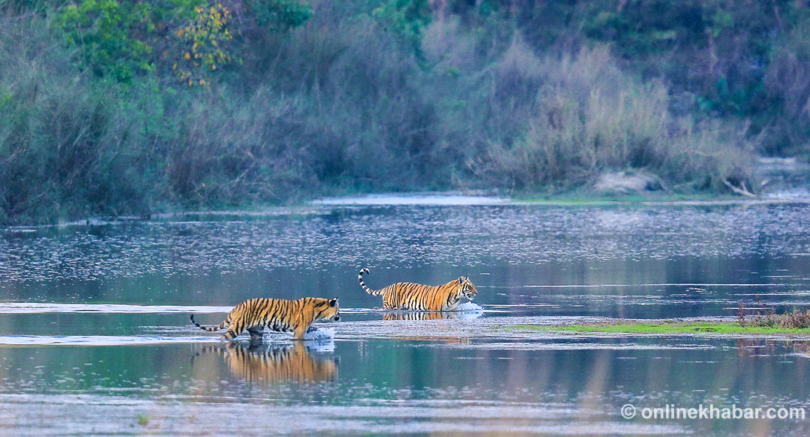
Bardiya National Park in far-western Nepal is Nepal’s second home to the Bengal tigers. The flora and fauna are similar to Chitwan National Park as it has Bengal tiger, Asian elephants, one-horned rhinoceros and leopards. Since most parts of the national park are open, people often site more animals here than in Chitwan.
The national park does have its fair share of forest cover as trees like sal, sissoo, khair, pipal, and silk cotton. Experts say the park is also home to over 300 species of birds like the Bengal florican, sarus crane, lesser florican, great hornbill, osprey and black-necked stork. Other migratory birds can also be found in one of the most visited national parks in Nepal during the winter.
As the national park has both the Karnali and the Babai rivers flowing through it, it also has aquatic animals like the mugger crocodile, gharial, marsh mugger, smooth-coated otter, Indian softshell turtle and freshwater dolphins. It also has a wide variety of fish including the golden mahseer, catfish, goonch Indian trout and spiny eel among a few.
Best time to visit: October to March
4. Sagarmatha National Park
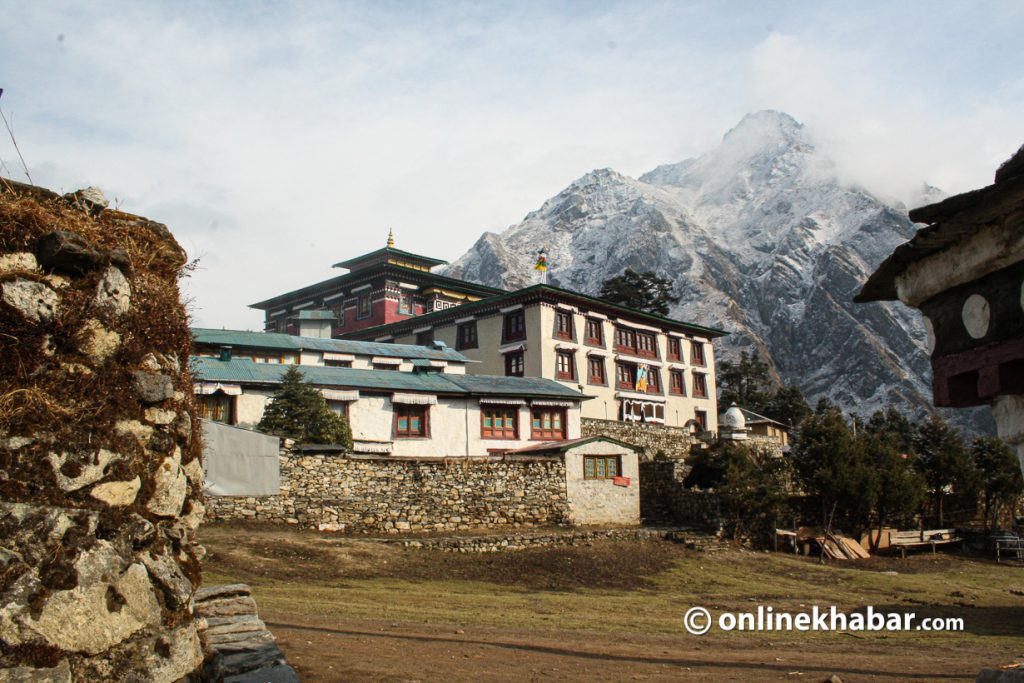
This is again one of the most visited national parks in Nepal as it is home to the highest mountain in the world, Everest, and other mountains like Lhotse, Ama Dablam, Mera, Lobuche and more. Sagarmatha National Park is also home to many endangered species like the snow leopard, red panda and Himalayan black bear. Other mammals found in the park are musk deer, Himalayan tahr and Himalayan wolf. One can also find different varieties of birds like the Himalayan monal, snow partridge, and yellow-billed chough.
Almost the entire national park is full of alpine and sub-alpine plant species such as rhododendrons, primroses and edelweiss. The lower elevations of the park have pine forests, hemlock and fir. Then, the higher elevations are full of small shrubs and rocky terrain along with massive glaciers, which are an important source of freshwater for the region and support a unique ecosystem of ice-dependent organisms.
Best time to visit: April-May and September – December
5. Khaptad National Park
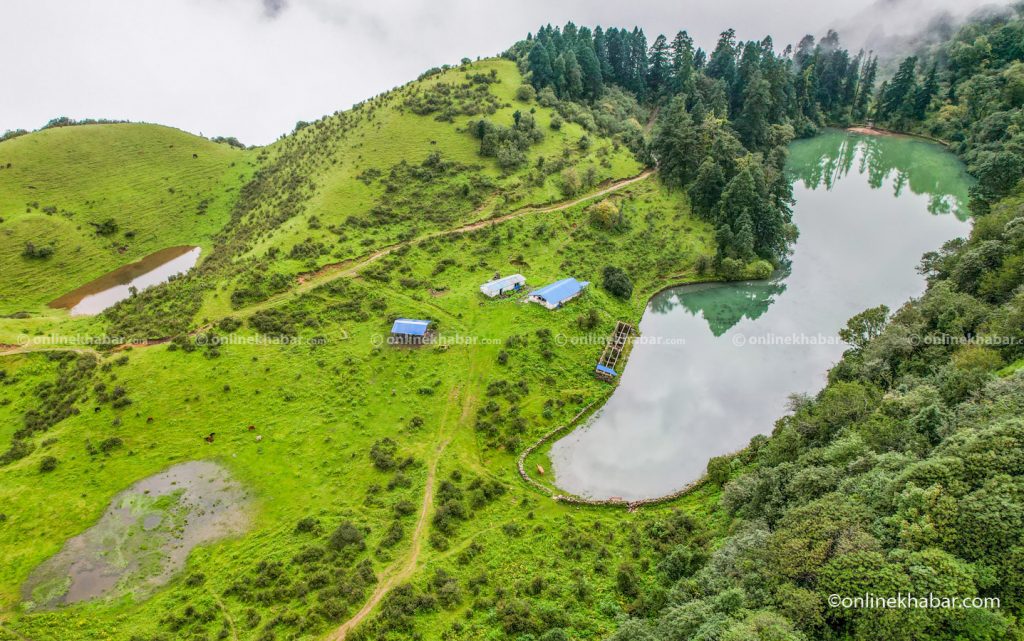
Khaptad is one of the most unique and biodiverse national parks in Nepal as it has a range of species adapted to the high-altitude conditions of the region. The park is an important conservation area for several endemic and endangered species. It is also a popular destination for trekking and wildlife viewing.
The park is home to several mammals including the Himalayan black bear, musk deer, and leopard cat. It also has barking deer, Himalayan tahr and red pandas. The park is also home to a variety of bird species, such as the imperial pheasant, snow partridge, and Himalayan griffon vulture. The area has fish in its wetlands like the snow trout, the Himalayan catfish, and the mahseer.
Like most national parks in Nepal’s hilly region, Khaptad is home to rhododendrons, oaks and maples while the lower elevation of the region has chir pine.
Best time to visit: October – December
6. Langtang National Park

Langtang is another high-altitude protected area located in Nepal. Just like in Sagarmatha and Makalu Barun, Langtang also has a diverse range of flora and fauna. Like most mountainous areas, the national park is home to the red panda, Himalayan black bear, musk deer and snow leopard. It is also home to over 250 species of birds including the Himalayan monal, blood pheasant and snow partridge.
In terms of plants, the Langtang region has endangered species such as the Himalayan larch along with rhododendron, oak, and bamboo. Experts say the park’s vegetation ranges from subtropical forests to alpine meadows and snow-covered peaks. The national park is also home to several glaciers and rivers that are an important source of fresh water and has high-altitude lakes like the Gosaikunda.
From Nepal’s capital Kathmandu, it is one of the closest national parks in Nepal.
Best time to visit: March – April or October – December
7. Rara National Park
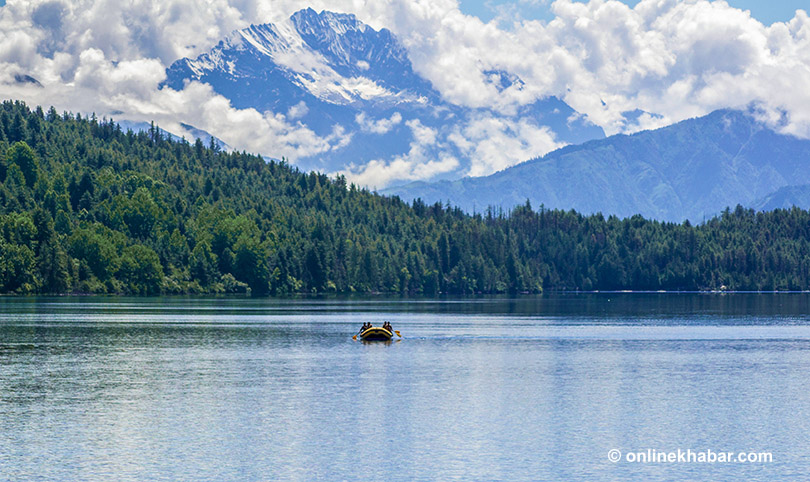
Rara National Park is one of the prettiest national parks in Nepal, located in the remote northwestern part of the country.
The area is home to several plants like the Himalayan yew, rhododendron and juniper. The park’s vegetation like most above ranges from sub-tropical forests to alpine meadows and snow-covered peaks.
Most animals found in the area are the snow leopard, ghorals, yellow-throated marten, Himalayan black bear, musk deer and red panda. There have also been citings of tigers and leopards in recent times in lower parts of the national park. It is also home to over 200 species of birds including the Himalayan monal, kalij pheasant, and snowcock. The national park is also home to fish like snow trout and common carp.
Best time to visit: March-May or October – December
8. Shey-Phoksundo National Park
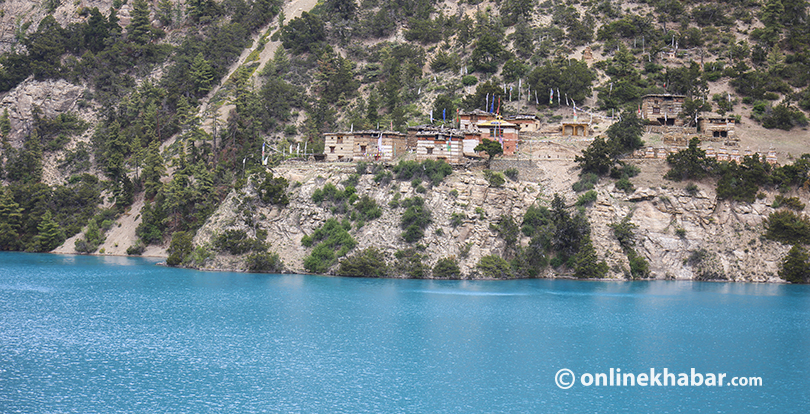
Shey-Phoksundo is the largest among national parks in Nepal, spanning over 3,500 square kilometres and is named after the beautiful Phoksundo Lake. It is known for its rugged terrain and deep gorges along with its mountains and culture. The landscape of the national park ranges from sub-tropical forests in the lower areas to alpine meadows high up.
Like most areas, the national park has rhododendrons, blue pine, deodar and oak trees along with juniper and birch. The national park is home to the elusive snow leopard and blue sheep. It has been extensively covered by Peter Matthiessen in his book Snow Leopard. Apart from that, the national park also has the musk deer, Himalayan tahr, Himalayan monal, Himalayan black bear, red panda, grey langur, impeyan pheasant and Tibetan snowcock.
The region also has freshwater fish like the snow trout, brown trout and the Himalayan grunter. The park’s lakes and rivers are also home to various species of aquatic invertebrates including water beetles, dragonflies and mayflies along with endangered animals like the Eurasian otter.
Best time to visit: April-May or October-November
9. Parsa National Park

Located in southern Nepal, Parsa National Park is a park that is full of pristine sub-tropical jungles. These tropical and subtropical forests provide a unique habitat for a variety of wildlife. The park adjoins the Chitwan National Park, one of the most-visited national parks in Nepal, and has similar flora and fauna.
The place is home to the Bengal tiger, Asian elephants and the one-horned rhinoceros along with sloth bears, leopards, deer, wild boar, jackal, pangolin and porcupines. Its wetlands are home to marsh mugger crocodiles, gharials, Indian pythons, Indian flap shell turtles and smooth-coated otters.
The national park is also a paradise for bird lovers as the park is home to the Bengal florican, great hornbill, peafowl, red junglefowl, white-throated kingfisher, common hoopoe and white-bellied drongo.
These birds are found in trees like teak, axlewood, Indian rosewood, harro, jamun, pipal, banyan and mango. The park also has a vast array of areas of grasslands and savannas, where one can find a variety of grasses and other herbaceous plants.
Best time to visit: February – April
10. Banke National Park

Banke is another national park in southern Nepal that is home to subtropical and tropical forests, riverine forests and grasslands. This means this national park too is home to a diverse range of flora and fauna.
The park is home to endangered species such as the Bengal tiger, Asian elephant, one-horned rhinoceros, swamp deer and gharial. Apart from that, the park also has other mammals like leopards, sloth bears, striped hyenas, wild dogs, golden jackals, fishing cats, mugger crocodiles, Indian pythons, and king cobras.
This is another paradise for bird watchers as it has over 250 species of birds like eagles, vultures, owls and water birds. The park also has Bengal florican, black-necked stork, lesser adjutant, sarus crane and white-rumped vulture.
The park has over 500 species of plants including rare and endangered plants like Swertia chirayita, Picrorhiza kurrooa and Dioscorea deltoidea and trees like sal, sissoo, asna, peepal, banyan among others.
There are aquatic animals like the golden mahseer, goonch, catfish, Indian trout and snow trout. Apart from that, the Babai river also has turtles and various species of crabs and shrimps. Additionally, the river ecosystem also supports a variety of aquatic plants such as water lilies, lotus, and water hyacinths.
Best time to visit: October-March
11. Shuklaphanta National Park

Located in the southwestern part of Nepal, Shuklaphanta is one of the most significant national parks in Nepal. The park’s wetlands include the Shuklaphanta lake, which is home to a rich aquatic biodiversity including various species of fish, amphibians and reptiles like Indian mottled eel, climbing perch, giant river catfish, giant snakehead, rohu and catla.
The national park also has the Bengal tiger, one-horned rhinoceros, swamp deer, Asian elephant, leopard, spotted deer, wild boar, gharial and Indian python. Like Banke, Bardiya, Chitwan and Parsa, Shuklaphanta also has tropical deciduous forests for the diverse wildlife. These trees range from sal, sissoo, khair, jamun, bamboo, elephant grass and kadam.
The national park is home to both residents and migratory birds like the Bengal florican, sarus crane, great hornbill, Pallas’s fish eagle, black-chinned yuhina and many more. Experts say over 300 species of birds are found there making it another ideal place for birdwatchers.
Best time to visit: October-March
12. Shivapuri National Park
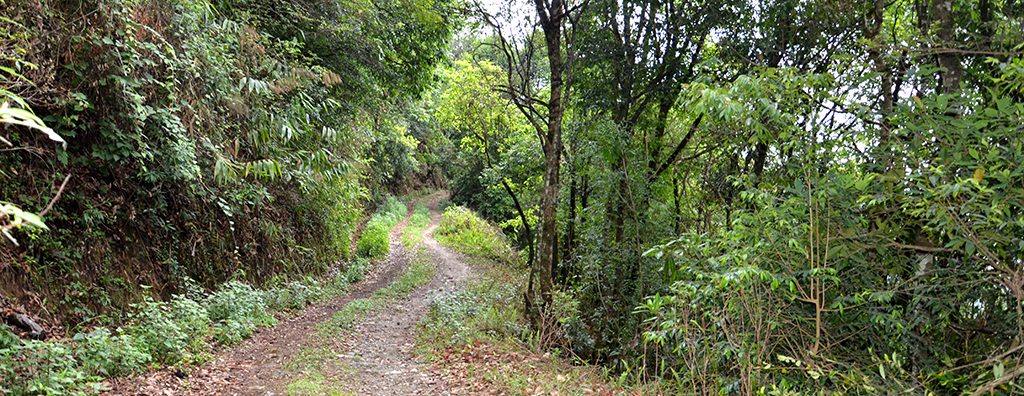
Shivapuri National Park is one of the smallest national parks in Nepal but has a diverse range of flora and fauna. Covering an area of 159 square kilometres, the park is home to mammals like the Himalayan black bear, leopard, wild boar, barking deer and rhesus monkeys among others.
The park also has over 150 species of birds like the Himalayan monal, koklass pheasant and various species of eagles, owls and thrushes that sit around rhododendron, oak, pine and Himalayan cedar trees. The park also has various species of wildflowers.
Additionally, Shivapuri National Park has several small rivers and streams that support a variety of aquatic life including fish, frogs, and other aquatic animals.
This is the only place among the national parks in Nepal that is adjacent to the country’s capital, Kathmandu.
Best time to visit: All year





